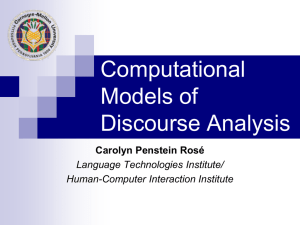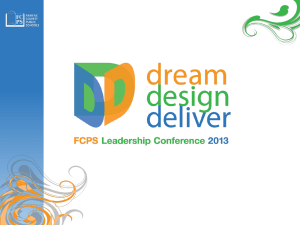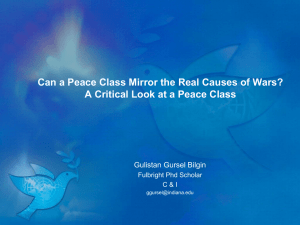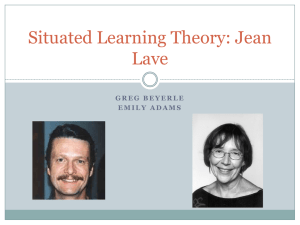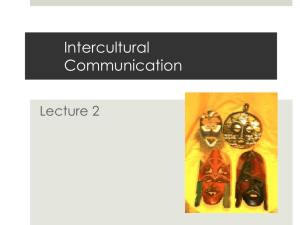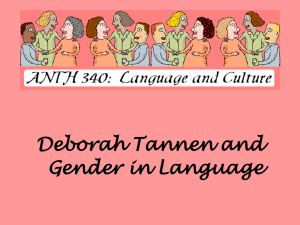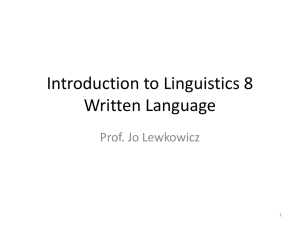Week 1 Lecture 2: Discourses and Figured Worlds
advertisement
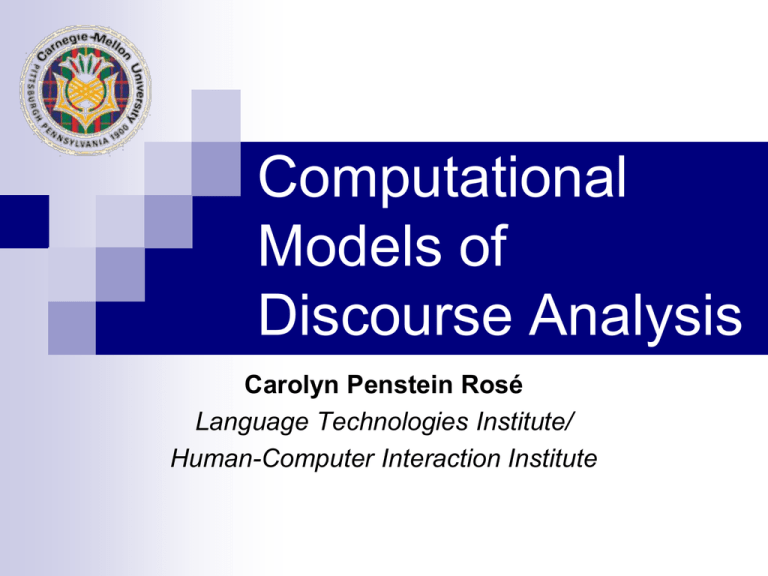
Computational Models of Discourse Analysis Carolyn Penstein Rosé Language Technologies Institute/ Human-Computer Interaction Institute Warm-Up Read the short conversation Jot down your thoughts related to the following ideas: What social languages are involved? What socially situated identities and activities do these social languages enact? How does intertextuality work in this discourse? What figured worlds are relevant, and what insights do they bring to light? Don’t worry if you can’t remember all the definitions. Trying to remember will prime you for learning during the lecture…. Styles of Analysis (Do David and Beka agree?) Eric: Our two styles of analysis are quite similar: first we frame the ‘text’ in its intertextual context, then we consider the heteroglossic possibilities of the text, and finally we draw our conclusions by interweaving the two together. David: I think my natural tendency in analysis is more story-oriented, favoring larger chunks or themes than much of Jim's element-based analysis. I find myself drawn to analyze and synthesize the whole of the piece to fit a single (critical?) lens, rather than treating the features and elements separately. ? Form-Function Correspondence Range of meanings for the word “sustainability” Discourse Environmentalism Socially Situated Identity Environmentalist Social Language Liberal rhetoric Figured World Expected structure of Conservationist Commercial Situated Meaning Meaning of “sustainability” in the commercial Imagine an environmentalist commercial Conversation Global Warming Discourse StatusQuo What do we gain from looking at these elements? Student Comment “Something that comes across from the analyses of the commercial in the reading and from class is how much thought went into the design of the commercial. Despite the number of themes in the commercial, they work together to convey a positive message about the product when you consider the target audience.” So today we’re talking about something less planned Student Quote One aspect that I had not considered before reading was Gee's analysis of the monsters. He assigns characteristics to the monsters (describing them as "tough, hard, destructive beings") and suggests that the viewers' impressions of them might change after seeing them fall in love. I hadn't considered the implications of that shift but I now think it plays an important role in how we view the rest of commercial. Please elaborate…. Discourses Definition: enacting a kind of social identity, like “being a real Indian” More than just language, exists apart from the individual people who enact that identity Involves more than language, for example, clothing and other “props” Scientists are “real scientists” when they contribute a scholarly argument How do you do “being an Environmentalist”? How do you do “being a discourse analyst?” Socially Situated Identities Definition: a role or “who doing what” More narrowly targeting one person’s role as part of a Discourse Example: daughter displaying her intelligence to her proud parents Example2: woman having a personal conversation with her boyfriend Warm-Up Read the short conversation Jot down your thoughts related to the following ideas: What social languages are involved? What socially situated identities and activities do these social languages enact? How does intertextuality work in this discourse? What figured worlds are relevant, and what insights do they bring to light? Don’t worry if you can’t remember all the definitions. Trying to remember will prime you for learning during the lecture…. Social Languages Definition: Style of language use associated with a socially situated identity Example: daughter displaying her intelligence to her proud parents “It seemed to me that Gregory should be the most offensive. He showed no understanding for Abigail…” Example2: woman having a personal conversation with her boyfriend “What an ass that guy was, you know, her boyfriend…” Note: same person, same viewpoint, same content, but different audience Warm-Up Read the short conversation Jot down your thoughts related to the following ideas: What social languages are involved? What socially situated identities and activities do these social languages enact? How does intertextuality work in this discourse? What figured worlds are relevant, and what insights do they bring to light? Don’t worry if you can’t remember all the definitions. Trying to remember will prime you for learning during the lecture…. Conversations Definition: Exchanges between more than one Discourse (e.g., ongoing debates) Example: Creationists versus Evolutionists Example: Liberal versus Conservative political debates Intertextuality Definition: Mixing, borrowing, or switching between social languages Occurs often within the context of a Conversation May also occur in other places More narrowly textual than a Conversation by pointing out the inflation of Saddam’s body count by neocons in an effort to further vilify him and thus further justify our invasion we are not DEFENDING saddam....just pointing out how neocons rarely let facts get in the way of a good war. So wait, how many do you think Saddam killed or oppressed? You’re trying to make him look better than he actually was. You’re the one inflating the casualties we’ve caused! Seriously, what estimates (with a link) are there that we’ve killed over 100,000 civilians. Not some crack pot geocities page either. Student Quote (agree or disagree?) The biggest enlightenment for me after reading Gee’s theory was the concept of ‘heteroglossia’ or multi-voicedness. This is important because we were trying to find the ‘one right answer’ in class, when in fact, everyone could have been right. For example, caring parents would see the advertisement as loving and soft, but people with insatiable egos would see the hummer as a force to be reckoned with—a vehicular manifestation of themselves. Warm-Up Read the short conversation Jot down your thoughts related to the following ideas: What social languages are involved? What socially situated identities and activities do these social languages enact? How does intertextuality work in this discourse? What figured worlds are relevant, and what insights do they bring to light? Don’t worry if you can’t remember all the definitions. Trying to remember will prime you for learning during the lecture…. Form-Function Correlations Definition: Linguistic knowledge that we use to interpret language Example: If a subordinate clause is fronted, that’s unusual, so we must be highlighting its significance Figured Worlds Definition: Theories or schemas that explain how the world works and provide expectations about how things go. Student Quote (comment about intertextuality, but connects nicely with figured worlds) We talked about several different themes going on in the commercial (i.e., Japan v America, monster movies, love stories, children, environmentalism, etc.) but we never really talked about where these themes came from, or how we knew about them. For instance, being able to identify the monster movie theme shows a sort of image-based intertextuality. It's a graphical theme borrowed from somewhere besides car commercials. Student Quote (comment about Conversations, but connects nicely with figured worlds) In Chapter 4, Gee talks about Conversations and missions statements as things that provide context for understanding discourse and as agents that influence discourse. Thinking about these concepts shaped my analysis of the Hummer commercial because many of the messages in the commercial are dependent on previous knowledge of concepts like: old monster movies, love stories, and information about the Hummer. Situated Meaning Definition: Using context to select one from many possible interpretations Example: expectation associated with “how are you?” when two friends meet for coffee versus when two acquaintances pass in the hall Warm-Up Read the short conversation Jot down your thoughts related to the following ideas: What social languages are involved? What socially situated identities and activities do these social languages enact? How does intertextuality work in this discourse? What figured worlds are relevant, and what insights do they bring to light? Don’t worry if you can’t remember all the definitions. Trying to remember will prime you for learning during the lecture…. Assignment 1 (not due til Jan26) Transcribe a scene from a favorite move, play, or TV show Select one of the methodologies we are discussing in Unit 1 (e.g., from Gee, Martin & Rose, or Levinson) Do a qualitative analysis of the script and write it up Use readings from Unit 1 as a collection of models to chose from Due on Week 3 lecture 2 As a shortcut, you can find a script online Excerpt should be no more than one page of text Turn in transcript, raw analysis (can be annotations added to the transcript), and write up (your interpretation of the analysis) Prepare a powerpoint presentation for class (no more than 5 minutes of material) Other Ideas: Twitter data, Google Groups, transcribe a real conversation (if your conversational partners agree…) Research Connection: Social Interpretation of Code Switching English-Tswana-Afrikaans-English (Casaburi 1994) [An extract from the inaugural address of Matsephe Casaburi, the first woman to be sworn in as provincial premier (i.e. governor) in South Africa’s Free State Province. Tswana is in italics. 'YOU CANNOT DISCOVER NEW OCEANS UNTIL YOU HAVE THE COURAGE TO LOSE SIGHT OF LAND. KE TLA SEBEDISA TSEBO YA KA GO BONTSHA GORE KE TLA KGONA GO KAONAPATSA PROVINCE YA RONA. ONS MOET SOOS BROERS EN SUSTERS SAAMLEEF EN NIE SOOS SWAPE SAAM STERF NIE. THANK YOU.' (TRANSLATION: “You cannot discover new oceans until you have the courage to lose sight of land. I will use my knowledge to show that we are capable of improving our province. We must live together like brothers and sisters and not die together like fools. Thank you.”) Questions?
